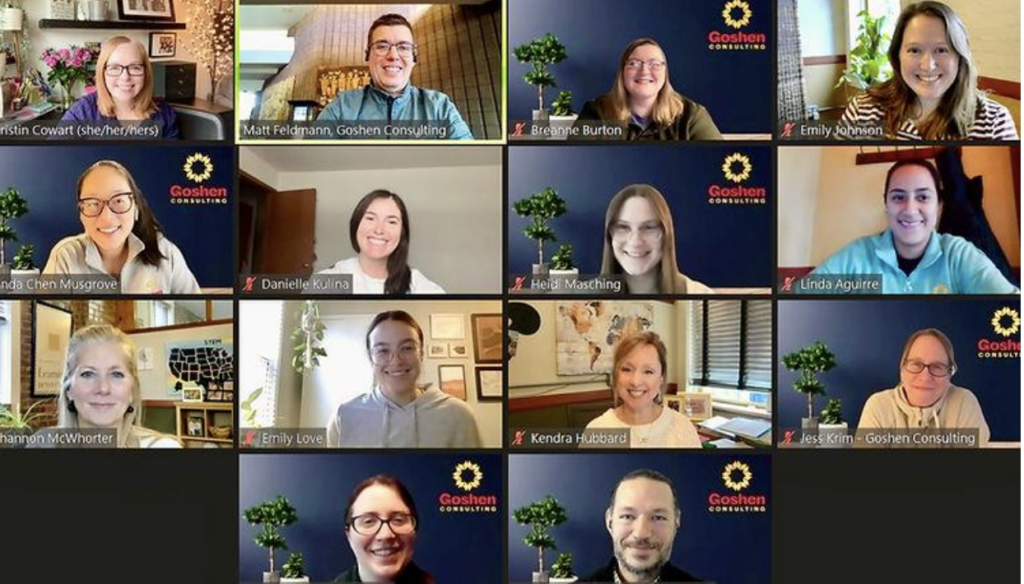Hi! I am Matt Feldmann with Goshen Consulting, an independent consulting firm that supports people dedicated to strengthening education and mental health systems through program design and evaluation, organizational development, and research. For this AEA 365 week, my colleagues and I are celebrating Goshen’s 15th anniversary. We would never have been able to grow the firm without grit, determination, and learning a few tricks and tips along the way, some of which we will share with you this week, beginning with MOUs.

MOU Refresher
Memorandums of Understanding are commonly called by their acronym, “MOU.” (Quick aside: I am not a lawyer, I am not providing legal advice, and I would greatly encourage you to meet with a lawyer with any questions about MOUs.) Investopedia defines an MOU as “an agreement between two or more parties outlined in a formal document. It is not legally binding but signals the willingness of the parties to move forward with a contract.” The key idea here is that it starts a process toward an agreement. If you are interested, you should download our Goshen MOU template.
Hot Tip
An MOU can lead toward a contract. Future evaluation clients often request support for grant writing long before they receive the funding and/or before they can offer you a contract. This is important to our business model. We provide pro bono grant writing support with the hope for future work. An MOU is an excellent way to lay out the groundwork for what is expected in the early stages of program development.
Lessons Learned
#1 Communicates Expectations
The primary purpose of an MOU is to communicate what your client should expect you to do and what you should expect from your client. We expect our clients to (a) include us (and our budget) in their proposal, (b) not reuse our evaluation plan without permission, and (c) remain responsive to our input (among other things). Our clients can expect us to (a) remain involved with the proposal writing team, (b) provide our portions of the proposal on or before our deadlines, and (3) sometimes provide support for data management plans and logic models.
#2 Signals Intent
An MOU can “get the ball rolling” toward an agreement. Many project directors don’t know where to get started in their own large organizations and an MOU helps them confirm their willingness to work with you. This can be helpful for you to understand where you “stand” with them.
#3 Allows Agreement in a Bureaucracy
Speaking of large organizations, our clients often work in large bureaucracies that are hard to navigate. An MOU formed during the proposal development stage has saved us the trouble of having to later bid on work that has been awarded because a purchasing department requires the provision of three competitive bids.
#4 Clarify Expectations
Finally, MOUs outline what both parties should anticipate from each other. For instance, we expect our clients to (a) include us and our budget in their proposal, (b) refrain from reusing our evaluation plan without permission, and (c) remain responsive to our input (among other things). In return, our clients can expect us to (a) actively participate in the proposal writing process, (b) deliver our sections of the proposal on or before deadlines, and (c) occasionally assist with data management plans and logic models.
Rad Resources
- IC TIG. If you are an independent consultant (or think you might want to be) you can learn A LOT more about these topics through the Independent Consulting TIG .
- IC Topic Chats. I also host a weekly community of practice session, called IC Topic Chats, that meet every Thursday at Noon ET. Use these embedded links to register or watch any of our YouTube videos on our channel. And, you can watch a video of me explaining MOUs at this YouTube Link.
The American Evaluation Association is hosting Goshen Consulting, an independent consulting firm. Do you have questions, concerns, kudos, or content to extend this AEA365 contribution? Please add them in the comments section for this post on the AEA365 webpage so that we may enrich our community of practice. Would you like to submit an AEA365 Tip? Please send a note of interest to AEA365@eval.org. AEA365 is sponsored by the American Evaluation Association and provides a Tip-a-Day by and for evaluators. The views and opinions expressed on the AEA365 blog are solely those of the original authors and other contributors. These views and opinions do not necessarily represent those of the American Evaluation Association, and/or any/all contributors to this site.
